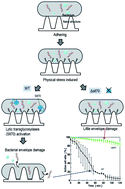Nanostructures exhibit a bactericidal effect owing to physical interaction with the bacterial cell envelope. Here, we aimed to identify the mechanism underlying the bactericidal effect of nanostructures based on bacterial autolysis, in contrast to previous reports focusing on structural characteristics. The time profiles of active cell ratios of the Escherichia coli strains (WT, ΔmltA, ΔmltB, Δslt70), incubation time of the wild-type (WT) strains, and autolysis inhibition of WT strains were evaluated with respect to the bactericidal effect of the applied nanostructures. Addition of Mg2+, an autolysis inhibitor, was not found to cause significant cell damage. The incubation phase was significantly associated with envelope damage. The lytic transglycosylase-lacking strain of Slt70 (Δslt70) also showed only minimal envelope damage. Our results indicate that nanostructures may act by triggering bacterial autolysis.

